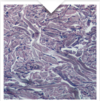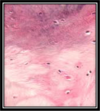Tissues and Cells of the body Flashcards
(34 cards)
Cuadal
toward the tail (coccyx)
Lateral
away from the midline
Medial
toward the midline
Proximal
toward the base
Distal
away from the base
Transverse
horizontal; separates superior and inferior
Sagital
separates left and right
Frontal (coronal)
Separates anterior(ventral) and posterior (dorsal)
Epithelial
arranged in sheets
regeneration

simple squamous epithelium
Bowman’s capsule, alveoli of lungs
reduces friction; controls vessel perm, absorption and secretion

Bowman’s capsule simple swquamous epithelium

stratified squamous epithelium
surface of skin, lining of mouth, throat, esophagys, rectum, anus, and vagina
physical protection against abrasion, pathogens, and chemical attack

stratified squamous nonkeratinizing epithelium in esophagus

simple cuboidal epithelium
glands, ducts, collecting duct of kidney, thyroid gland
limited protection, secretion, absorption

simple cuboidal epithelium in collecting duct of kidney

stratified cuboidal epithelium in sweat glands

stratified columnar
2 layers
can be seen in soft palate, larynx,
Pharyx and salivary glands

transitional epithelium
urinary tract
permits expansion and recoil after stretching

Areolar connective tissue (loose connective tissue)
mostcommon type of connective tissue
holds organs in place
connects epithelial cells to the underlying tissues,
it also surrounds blood vessels and nerves

Dense regular connective tissue
tendons and ligaments
firm attachment, pull of muscles, reduces friction, stabilizes bones

dense irregular connective tissue
dermis
strength to resist force applied from many directions
helps prevent overexpansion

Hyaline Cartilage (specialized connective tissue)
chondrocytes in lacunae
covering bone surfaces at synovial joints, supporting the larynx, trachea, and bronchi
provides flexible support, reduces friction btwn bony surfaces

Hyaline cartilage in trachea
glassy ECM

elastic cartilage
ear, epiglottis
tolerates distortion without damage and returns to original shape
chondrocyte in lacuna












